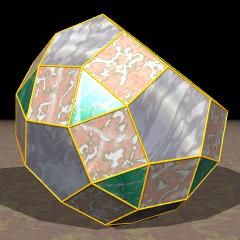
I got the idea that perhaps partial Stott expansion can be extended to symmetries other than n-cube symmetry. Consider the above picture, for example. If you imagine the pentagonal faces being "pushed inwards" so that the triangles and squares collapse into points and edges respectively, then the result is a regular dodecahedron. So the reverse process, going from the dodecahedron to J80, is just like regular Stott expansion/contraction except that the two decagonal faces did not undergo a full expansion, but only a partial expansion in their respective planes (pentagon -> decagon). Or, another way to look at it, is that two different Stott expansions are taking place here: the pentagon->decagon expansion (which, if applied to the entire dodecahedron, would yield a truncated dodecahedron), and the {pentagon->pentagon, vertex->triangle, edge->square} expansion (which, if applied to the entire dodecahedron, would yield the (non-diminished) rhombicosidodecahedron). These two expansions just so happen to share a compatible interface, so they can take place simultaneously within different parts of the dodecahedron.
I haven't tried specific cases in 4D yet, but it does seem promising as another way to search for CRFs in the 120-cell/600-cell family of polychora. Specifically, I wonder if there's a hybrid Stott expansion that may somehow produce a polychoron with pairs of J80 conjoined at their decagonal faces -- this may turn out to be a new kind of CRF that perhaps isn't obtainable via ordinary cut-n-paste operations? E.g., if we imagine the 120-cell being partially expanded in such a way that some cells aren't fully expanded into x5o3x's, but become J80's or some of the other x5o3x diminishings. I don't know for sure whether this is actually possible (with CRF results), but it seems to be an interesting new direction to explore.

 )
) , except for that I also add lengths to the edges of the simplex, with which you can calculate whether it's a valid polytope or not. (It's not a very big change, but it can make it easier to calculate catesian coordinates for it)
, except for that I also add lengths to the edges of the simplex, with which you can calculate whether it's a valid polytope or not. (It's not a very big change, but it can make it easier to calculate catesian coordinates for it) 
 . I'll try to pay attention to it in the future though.
. I'll try to pay attention to it in the future though.